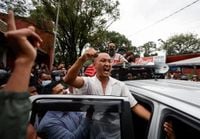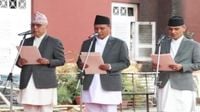On September 15, 2025, Nepal’s battered capital, Kathmandu, was abuzz with cautious hope and the hum of political change. At precisely 4:30 PM, inside the historic walls of Singha Durbar, Sushila Karki, the country’s newly appointed interim Prime Minister, convened her first Cabinet meeting. The gathering was the culmination of a whirlwind week that saw Nepal’s leadership upended by a Gen Z-driven protest movement, the resignation of former Prime Minister KP Sharma Oli, and the swearing-in of three new ministers—each handpicked for their experience and, perhaps more importantly, their ability to steady a nation rocked by violence and uncertainty.
The Cabinet expansion, which took place earlier that day at Sital Niwas, the Presidential Palace, was a carefully orchestrated affair. According to ABP Live, President Ramchandra Paudel administered the oath of office to Kulman Ghising, Om Prakash Aryal, and Rameshwor Khanal in the presence of senior officials. Ghising, a well-known figure credited with ending Nepal’s chronic power outages, was tasked with overseeing the Ministry of Energy, Urban Development, and Physical Infrastructure. Aryal, a legal advocate with a reputation for public interest litigation, assumed the Ministry of Law and Home Affairs, as well as the Ministry of Labour, Employment, and Social Security. Khanal, a former finance secretary, returned to government as Finance Minister and also took on the Ministry of Communications and Information Technology.
Karki’s own rise to power was nothing short of historic. As reported by The Kathmandu Post and NDTV, the 73-year-old former Chief Justice became Nepal’s first woman to hold the office of Prime Minister—albeit in an interim capacity. Her appointment followed days of Gen Z-led protests, which erupted on September 8 after the government imposed a controversial ban on major social media platforms. The ban, coupled with simmering public anger over corruption, inequality, and government inertia, brought tens of thousands of young Nepalis to the streets. What began as peaceful marches quickly spiraled into deadly clashes with authorities, leaving at least 72 people dead and over 1,300 injured, according to Reuters.
The protests, coordinated in large part through the Discord messaging app and Instagram, were spearheaded by Hami Nepal (“We are Nepal”), a non-profit founded by former DJ Sudan Gurung. Using VPNs to bypass the bans, Gurung and his team issued calls to action that reverberated across the nation’s youth. “I was invited to join a group on Discord where there were about 400 members. It asked us to join the protest march a few kilometres from the parliament,” 18-year-old student Karan Kulung Rai told Reuters. As the movement gained traction, Hami Nepal’s social media posts became so influential they were referenced on national television. The group also worked to identify fake news and provide critical information, such as hospital phone numbers, during the chaos.
Despite their newfound influence, Gurung and his associates have been adamant about staying out of formal government roles. “We don’t want to be politicians. Sudan Gurung was only helping the ‘Gen Z’ group, and we are only the voice of the nation and not interested in taking leadership positions,” said Ronesh Pradhan, a 26-year-old volunteer, in an interview with Reuters. Instead, the group has focused on ensuring the interim government reflects the will of the people and includes skilled, capable youth. “The process is being carefully carried out, so that it consists of skilled and capable youth,” Hami Nepal stated on Instagram.
Behind closed doors, Gurung and his team played a pivotal role in shaping the new government. According to Reuters, they convinced both President Paudel and the Army Chief to endorse Karki’s appointment. Over the weekend of September 14–15, they participated in meetings to finalize cabinet positions and discuss the removal of officials appointed by the previous administration. “Meetings are ongoing between Karki and members of the group. We will finalise the cabinet soon,” a Hami Nepal member told Reuters.
The Cabinet’s priorities are clear—and urgent. On the streets of Kathmandu, citizens voiced a litany of needs: jobs, homes, food, healthcare, education, and, above all, a return to peace. “The new government should first focus on rebuilding damaged buildings,” said Rudra Gautam, a local driver, to AFP News Agency. “People need homes, food, healthcare, education, and jobs. Give us employment—that’s what matters.” Shopkeeper Satya Narayan echoed the call for swift elections: “The public wants a clear roadmap. Elections within six months will meet Gen Z’s demands and restore trust. Women should also feel safe and respected.” Ram Lal Sundar, an iron worker, added, “Everything destroyed in the arson—homes, vehicles—must be rebuilt. Lives were lost, houses were burnt. The government must heal these wounds and bring happiness back.”
The Cabinet itself is a blend of technocratic expertise and reformist intent. Ghising, for example, is lauded for resolving Nepal’s long-standing power crisis during his tenure as managing director of the Nepal Electricity Authority—a fact not lost on those who remember the days of chronic blackouts. Aryal, a legal advisor to Kathmandu Metropolitan City and a seasoned advocate, brings a focus on justice and public accountability. Khanal, with his background as a finance secretary, is expected to steer Nepal’s fragile economy through this turbulent transition.
Karki’s legitimacy, meanwhile, rests on her reputation for integrity and independence. Chosen through an online vote on Discord by leaders of the youth-led protests, she represents a rare consensus figure—acceptable to both the reform-driven youth and the seasoned politicians seeking calm after weeks of violence. Since taking office, she has begun consultations with advisors and representatives from the Gen Z movement to shape her Cabinet and set priorities, according to The Kathmandu Post.
Yet challenges abound. The wounds from the protests are still raw, with families mourning lost loved ones and communities struggling to rebuild. The demand for elections within six months looms large, as does the expectation that the interim government will deliver tangible improvements in daily life. Sudan Gurung, in his first press conference since the protests, summed up the mood: “I will make sure that the power lies with the people and bring every corrupt politician to justice.”
As Nepal stands at this crossroads, the coming months will test whether the country’s first woman interim Prime Minister and her diverse Cabinet can deliver on the promises of peace, reconstruction, and a new kind of politics—one shaped, for the first time, by the digital voices of a restless generation.





